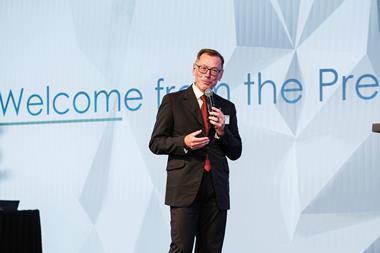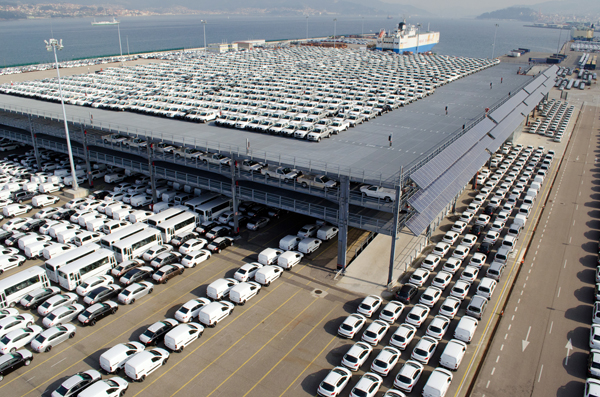 Our 2014 survey shows growth across vehicle-handling ports, helped by sales recovery and exports. However, some countries and operators are struggling in the face of declining trade and new regulations.
Our 2014 survey shows growth across vehicle-handling ports, helped by sales recovery and exports. However, some countries and operators are struggling in the face of declining trade and new regulations.
Europe’s vehicle industry continues through a cautious recovery, as demonstrated by sea shipments of light vehicles across the greater continent’s primary ro-ro and vehicle-handling ports. Our annual survey of more than 40 ports and port conglomerations continues to reflect regional disparities, although there have been some noticeable changes both within country groupings and
among specific ports.
Overall, European ports, including Turkey and Russian ports in the Baltic Sea, handled more than 18.65m new light vehicles in 2014, which amounted to slightly more than 4% growth compared to 2013, while EU-only ports grew by 4.8% to 17.08m (which puts our survey in line with the 5.6% growth EU markets recorded in passenger vehicle sales in 2014).
The headline growth, however, masks a number of declines among individual ports and regions, as Europe’s recovery in vehicle sales and production remain tepid at best. While a number of ports in Germany, Benelux, the UK and Spain performed well, others struggled. French ports, for example, declined by nearly 15% compared to our 2013 survey, including a 25% drop in imports at Le Havre. The Greek port of Piraeus, largely a transhipment hub for markets in south-east Europe, the Black Sea and the Middle East, declined by nearly 20%.
The ports of Ust-Luga and St Petersburg, together with those that serve them via transhipment, have been hit hard and are facing even steeper declines. Carrier and terminal operator Russian Transport Lines expects to handle 25-30% less volume this year, says director Konstantin Skovoroda.
Meanwhile, Finnish ports that have traditionally handled some of the volume destined for Russia are also suffering. Anders Ahlvik, managing director at the port of Hanko, says that the unstable situation in Ukraine and the embargo between EU and Russia continues to have a negative impact on transhipments, which dropped nearly 50% at the port last year. Volumes are expected to drop further this year.
For short-sea carrier UECC, changes in Russia will also become more evident as it experiences significant volume reductions, according to Bjørn Svenningsen, head of sales and marketing. “We will maintain our network during 2015, but need to consolidate and take out as much operational cost as possible,” he reveals.
As well as unstable markets both within Europe and on its periphery, there are also regulatory worries that could have specific impacts for finished vehicle ocean shipping in 2015. In January of this year, the long-awaited Sulphur Emission Control Area (SECA) came into effect for the Baltic Sea, North Sea and English Channel, requiring shipping lines to use fuel that contains no more than 0.1% sulphur (the requirements also came into effect on the US and Canadian coasts). This has already prompted short-sea carriers to discontinue some routes. However, with fuel prices at unexpected lows, many carriers are experiencing a balance between higher-grade fuel requirements and actual fuel costs – at least for now. Some ports outside the SECA area are also gaining favour with carmakers.
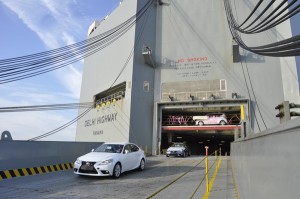
In the individual port rankings, Belgium’s Zeebrugge, a major hub for deep-sea imports, transhipments, and short-sea trade routes made a somewhat surprising move back to the top position in 2014, handling more than 2.2m vehicles. Zeebrugge had surrendered the crown in 2011 to Germany’s Bremerhaven after nearly a decade on top of our surveys. The German port handled just 5,000 fewer cars than Zeebrugge overall last year, but saw declines in its business with Russia.
Unsurprisingly, Germany continues to dominate volume in exports, and despite only three ports being included among this year’s survey (Bremerhaven, Emden and Cuxhaven), they combined to handle the most vehicle volume as measured by country, at 3.94m imports, exports and transhipments. However, the UK’s recovery in vehicle sales and steady exports have led its ports – which include six ports or port conglomerations in our survey – to pull within fewer than 50,000 vehicles of Germany (the survey has not captured volume from a number of smaller vehicle-handling ports in either country, however). Indeed, the UK’s buoyant import trade is cited among port operators as a driving factor in export growth at a number of major ports, including Zeebrugge, Emden and Spanish ports.
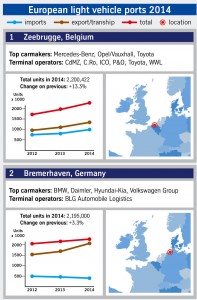
While trade has not been booming overall, the increasing traffic has led to congestion and bottlenecks in some ports, both at sea and on land. To ease congestion and improve overall efficiency, many ports across Germany, the UK, Belgium, Spain and Italy are investing in rail capacity to help improve inland connections. Italy’s Livorno, the country’s second largest port last year for vehicle handling, is a good example, as it prepares to start handling Daimler exports headed to Asia, which will arrive from Germany by rail.
Zeebrugge on top, but Bremerhaven hits a high
According to our survey records, Zeebrugge’s 13.25% growth in 2014 over 2013, to 2.2m vehicles, brought its volume just 8,000 vehicles shy of its 2007 high. Marc Adriansens, managing director at International Car Operators (ICO), which operates major terminals in Zeebrugge and Antwerp, says that Zeebrugge experienced notable trade growth with Africa, North America, and the UK. He points out that Zeebrugge has become more highly concentrated as a hub port, with a greater number of sea carriers and increased calling frequency. Among the notable changes is that Scandinavia’s network of carriers has grown, he says.
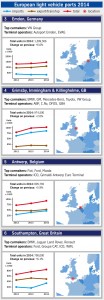
Last year, ICO’s Hanze Terminal at Zeebrugge expanded from three to 12 hectares. “Previously, we had to discharge vehicles at the adjacent Toyota terminal. Now, handling time has been reduced; we can handle a vessel in one shift instead of two,” says Adriansens.
At just shy of 2.2m units, the port of Bremerhaven handled more vehicles in 2014 than it has ever done before. Exports grew around 15% from Bremerhaven, to 1.9m units, equal to the number of exports recorded in our survey at all ports in Turkey, Italy, Scandinavia and France combined. According to Wolfgang Stöver, director of sales and marketing at BLG Automobile Logistics, the port’s operator, exports to Asia and North America drove growth along with recovery in parts of Europe. Imports (which include transhipment figures in this case) fell sharply, largely as a result of 50% fewer movements through Bremerhaven to Russia. Imports nevertheless increased from BMW’s plant in Spartanburg, South Carolina, as well as Daimler’s contract manufacturing with Valmet in Finland.
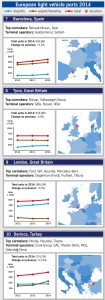
Although it is in a region that has been hard hit by the economic crisis, Spain’s automotive sector has shown signs of renewed strength. Car production in the country totalled more than 1.87m units in 2014, an 8.9% rise compared to 2013. Total export volumes rose by 9.2% to around 1.63m units (differences in our survey, which recorded 1.66m exports from Spain’s ports, are down to transhipment and different ways that ports count their figures, especially considering that Spain exports vehicles to European countries by land as well).
Among the leading exporters is Volkswagen Group-owned Seat. Last year, the carmaker’s exports from the port of Barcelona, Spain’s largest vehicle handling port, increased by more than 8% to 194,347 units, a significant share of the port’s 527,600 exports. Audi production in Spain has also been an important driver of growth. The port of Emden, in Germany, for example, has seen import figures from Spain increase by 22%, mainly because of the Audi Q3 built by Seat, according to Jörg Tuitjer, head of division automotive at terminal operator EVAG.
According to Lluis Paris, commercial manager at Barcelona, OEMs have consolidated more European manufacturing in Spain. While exports to North Africa and the Middle East have slowed because of political and economic problems, exports to East Asia, particularly South Korea, have grown. Trade has also increased by short sea to regions like the eastern Mediterranean, Turkey, Italy and Israel.
“We have seen service improvement from short sea lines such as EML, Neptune, Grimaldi, and Suardíaz that provide much better service to ports within Europe,” says Paris. “Predictions are for the domestic economy to recover at a slow but steady pace. We expect growth of about 5%, which should be more on the export side.”
The port of Barcelona has increased its berthing area with three more spaces, two of which are for deep-sea traffic. It has also reserved 24 hectares for its car business that are contiguous to the current car terminals.
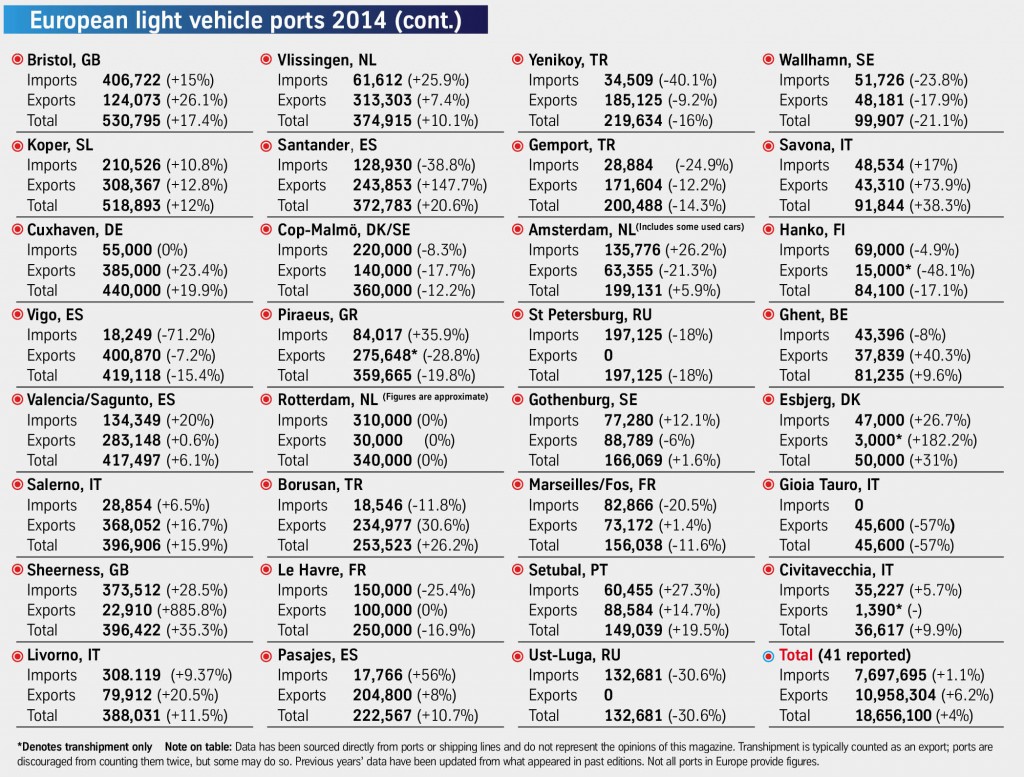
Along with exports, the port authority also saw a 20% rise in imports last year, with increases in vehicles shipped from Italy, the UK, Belgium, Turkey, and Japan. Another growth indicator is that Toyota Motor Europe, which operates a distribution centre at the port of Sagunto, has requested 14,000 sq.m of added space for its facility.
The port of Santander, located in the Bay of Biscay in northern Spain, also expects a record year in 2015 following one in 2014. The Volkswagen Group’s exports from the port doubled in 2014, after new destinations were added for the Audi Q3, including to Australia, New Zealand and South Africa, markets which WWL is serving with extra calls from Santander. A new quay at the port will also increase vessel capacity to 291 metres in length with a draft of 13 metres.
Cristina Lopez Arias, general manager at the port, says that while the growth in exports is certainly welcome, the mismatch with imports is a serious issue for logistics efficiency at Santander. Across Spanish ports, there are now four times as many exports as imports.
The port of Vigo was Spain’s only vehicle port to lose volume last year, experiencing a decline in both imports and exports. “Global factors such as the Ukraine crisis have affected several manufacturers’ production. PSA also ceased exports due to Algeria halting imports of new cars from Europe in 2013 due to its end of its incentive programme,” says Lola Rois Orza, commercial manager, from the Port Authority of Vigo.
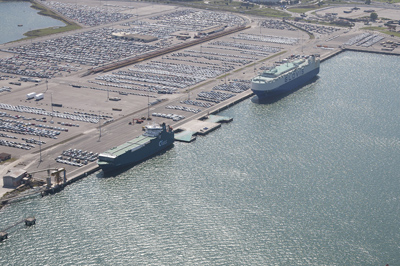
The construction, which is expected to be completed by December this year, will include establishing an exclusive area in the east zone of the Bouzas Terminal to be used by traffic generated by the short-sea service operated by Suardíaz. Among the cargo handled will be finished vehicles, including those from PSA Peugeot Citroën. A tender for the construction of a new ro-ro ramp has already resulted in a €3.5m contract having been awarded. Again, the EU will pick up €640,000 of that bill.
On the eastern side of the terminal, an area is to be created to allow vessels to be moored, using four pilot structures. This will make it possible for ships of up to 200 metres in length to be handled there. The project, which has a budget of €4.8m, is expected to be put out to tender shortly.
Sluggish south
Other than the general growth in Spain, trends at southern European ports have varied. Greece’s Piraeus, despite a rise in imports, was hit by a 29% decline in transhipment last year, primarily because of the unstable situations in Crimea and the Black Sea, North Africa, and the Middle East, according to Thanassis Karlis, head of marketing at the Piraeus Port Authority. “Lower fuel prices have meant that direct services to North Africa and the Middle East are now more economically viable,” he says. “This has placed downward pressure on the transhipment volumes that went through Piraeus.”

In south-east Europe, the Slovenian port of Koper’s vehicle throughput increased by 12% in 2014 to nearly 519,000 units. Car terminal director Gregor Belic says the port is shipping more new vehicles to other Mediterranean countries, particularly for Volkwagen, Hyundai, Kia, and BMW. “We are exporting more to Turkey, which is our main market, as well as Israel. With the growth of European production, we expect the export trend to continue in 2015,” he says. In 2014, Koper doubled its open storage area to 4,000 parking slots.
Despite moderate improvements in the overall French vehicle market, last year saw a general decline in French ports, particularly for exports. But as carmakers in the country change their production networks, ports are responding. At the Port of Marseilles-Fos in southern France, the new TEA terminal is now operating and Dacia vehicles built by the Renault Nissan plant in Tangiers, Morocco are now arriving. The first car arrived in April 2014, and TEA is expecting more than 20,000 Dacias per year.
Britannia rides a wave
British ports saw increases in our survey last year of 6.8% to nearly 3.9m imports and exports. While the UK overall has experienced a steady rise in exports, the largest activity for its vehicle-handling ports remains imports. Ports such as Bristol and Sheerness have experienced double-digit import growth. This has also been driving significant volume at a number of other ports in Spain, Belgium and Germany. From the port of Emden, which is the Volkswagen Group’s principal export port from Germany, shipments to the UK have increased by 35% between 2012 and 2014, to nearly 500,000 vehicles, says EVAG’s Jorge Tuitjer.
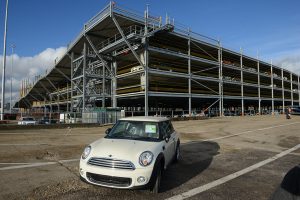
Exports have also been an important factor in the UK’s growth, with China now the single largest destination market from the country. The port of Southampton was the country’s largest for export last year and is a major deep-sea service hub. To increase capacity, the port is working on a 3,000-space extension to a multi-storey car park and mafi storage compound in its Eastern Dock area. “We are also developing a new compound in the Western Dock for 2,500 spaces to open in Q2 2015,” says Clive Thomas, port manager for Associated British Ports, which operates the port.
Trade with the rest of Europe remains the largest volume for the UK. Simon Stacy, head of logistics for Honda Motor Europe, says the carmaker has experienced a surge in its exports from the country. Honda uses Southampton primarily, with some volumes via Bristol or Immingham.
Stacy adds that Honda has further centralised its port network across Europe. It now imports vehicles into two main compounds, then distributes sold orders from these locations: Bristol, for the UK, and Ghent, via Zeebrugge, for the continent. It also uses Santander as the single inbound port for vehicles destined to Spain and Portugal.
The sulphur divide
Sean Potter, managing director of DFDS Seaways, says the higher costs of SECA regulations have already led it to close routes between the Danish port of Esbjerg and Harwich in the UK, as well as between Gothenburg, Sweden and Tilbury, near London, and a few others. Henrik Otto Jensen, CEO of Scandinavian Auto Logistics (SAL), which operates a terminal at Esbjerg, is concerned about the amount of regulation facing the maritime industry.
On the other hand, lower fuel prices have made it easier for carriers to adapt to the new requirements. In August 2014, the cost of fuel that would be required for compliance with SECA regulations was high, with standard fuels ranging from about $600 per tonne compared to compliant, 0.1% sulphur fuel at more than $900 per tonne. In January, the latter was at $450 per tonne or lower.
“SECA’s impact has been neutralised with this fuel cost reduction. This is important for us because a significant percentage of our maritime routes, such as to the UK and Germany, are within the SECA zone,” says Manuel Medina, manager of finished vehicle distribution at Spanish carmaker Seat.
On the other hand, ports just beyond the SECA zones, whether in the Irish Sea or southern Europe, may experience something of a competitive lift, since they are not yet required to meet the 0.1% sulphur requirements. Tony Dent, business development manager at the Bristol Port Company, says that since the port is outside of the SECA zone, shipping lines have an advantage in calling there, particularly from Mediterranean and deep-sea regions that are also outside SECA zones. “Deep-sea exports have been a new feature this year, while export volumes generally have been higher than in 2013, particularly to Mediterranean destinations,” he says.
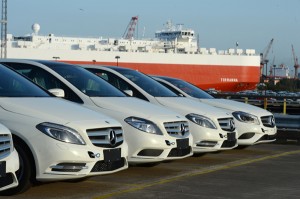
However, all ports are likely to see some impact from the new regulations. Cristina Lopez Arias, at the port of Santander, admits that she was worried the SECA rules would impact the port even though it is not directly in the emission area. “Initially we predicted an increase in freight costs as there are currently no car carriers operating with LNG (liquified natural gas) and many ship owners are installing scrubbers or using fuel with low sulphur content. The considerable drop in the price of oil is greatly reducing this effect,” she says.
While lower fuel prices might be mitigating regulatory rises, UECC’s Bjørn Svenningsen does not see them as a bonus overall for carriers. “Lower fuel prices will have no significant impact since we have bunker adjustment factors in the contracts with our customers,” he says.
Getting on track for efficiency
Overall, the growth in trade for Europe has been good news for shipping lines. While UECC has seen declines in Russian-related trade, it experienced a 4.2% volume increase from 2013 to 2014. It has also added new services, including to Sagunto, Spain and between Cuxhaven, Germany and Immingham in the UK. At the port of Pasajes, located in the eastern Bay of Biscay, where UECC operates a terminal, volumes increased by nearly 11%.
Flavio Batista, head of commercial for Europe, Middle East, and Africa at Wallenius Wilhelmsen Logistics, points to strong exports out of Europe, along with relatively stable imports, that continue to drive port and shipping activity. However, he does note some congestion and capacity issues at a number of ports, including Zeebrugge, Bremerhaven, and Southampton.
“Stagnant import volumes combined with strong exports are naturally creating congestion, which remains a significant challenge going into 2015,” says Batista. Labour shortages at key European ports have also posed problems.
According to Svenningsen, UECC has experienced port congestion in Turkish ports and at Bremerhaven.
Exports and vehicle handling by sea are also driving significant flows of vehicle by rail. A notable example is Daimler’s recent decision to use Italy’s port of Livorno to export vehicles to China as another exit point, along with northern ports. According to port of Livorno analyst Saverio Failli, the expected new car flows will arrive mainly by rail to the port from Germany. “Car manufacturers are seeking smoother integration of port and rail operations,” he says.
Such rail flows are prompting port operators to invest in expanded yard and infrastructure capacity. At Livorno, which handled 388,000 units last year, the port has been upgrading the rail accessibility of its berths, including a closer integration with the nearby Guasticce Freight Village, which has its own railway terminal, a surface area of more than 2m sq.m, and major inland new car terminal in Italy. Failli says that new railway connections among these facilities and the hinterland will ensure direct railway service from port to customer.
At Bremerhaven, Wolfgang Stöver reveals that the increased shipping cost from SECA regulations is leading some carmakers, including Volkswagen, to consider new rail flows, such as from Germany to Sweden. BLG is building a multi-storey car park to be able to store up to 7,000 more cars in the export terminal, while also expanding its railway yard. Both projects are expected to be complete around October this year.
“About 95% of all export cars arrive in the port of Bremerhaven by rail,” says Stöver. “Therefore, the further focus is to adjust the railway structure by expanding marshalling and shunting yards, and by creating more tracks and unloading stations in the terminal itself.”
Rail investment is also playing a significant role at the port of Antwerp, where the Liefkenshoek railway tunnel opened in December 2014, offering a direct and faster rail connection for cargo between the port’s left and right bank. Meanwhile, at the port of Esbjerg, a new rail terminal now provides direct access to SAL’s terminal.
"SECA’s impact has been neutralised with this fuel cost reduction. This is important for us because a significant percentage of our maritime routes, such as to the UK and Germany, are within the SECA zone" - Manuel Medina, Seat
Last year, the port of Southampton completed a £1.2m ($1.8m) upgrade to its Eastern Dock rail network, which has enabled the port to take two longer ten-wagon trains onto the site simultaneously.
In Barcelona, the port has improved its rail connections with a new terminal on the pier that will open by July with three 630-metre tracks for both the standard UIC used in most of Europe, and the Spanish rail gauge. Lluis Paris says that this facility will be able to handle 750-metre trains. Meanwhile, among Santander’s latest developments is a fourth railway line for car trains of 666 metres in length.
Railway operations began at the port of Valencia in 2013 and now handle shipments from plants in Zaragoza and Valladolid for Opel, Renault, and Iveco. Jorge Civera Perez says that in 2014, the port authority offered a rebate of 15% on port fees for using rail and, in 2015, this giveback has increased to 30%.
Such investments will be welcome in Europe’s port network. While volume is uncertain across and may continue to see disparities in growth and decline, it is clear that the European automotive industry depends upon multimodal logistics to link its plants and consumer regions to major port gateways. Such handling is not only an efficiency gain for these ports – it is part of their distinctive competitive advantage.
Christopher Ludwig contributed to this report.
































